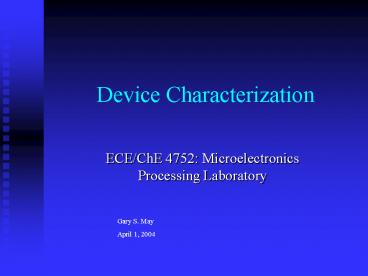Device Characterization - PowerPoint PPT Presentation
1 / 33
Title:
Device Characterization
Description:
NMOS Device Physics. PMOS Device Physics. CMOS Inverter. MOSFET ... Equation: ... Appropriate I-V equations found by: 1) reversing the direction of ID ... – PowerPoint PPT presentation
Number of Views:145
Avg rating:3.0/5.0
Title: Device Characterization
1
Device Characterization
- ECE/ChE 4752 Microelectronics Processing
Laboratory
Gary S. May April 1, 2004
2
Outline
- NMOS Device Physics
- PMOS Device Physics
- CMOS Inverter
3
MOSFET
- MOSFET Metal-Oxide-Semiconductor Field-Effect
Transistor - Terminals
- G gate
- D drain
- S source
- B body (substrate)
4
MOSFET Key Quantities
- Currents
- IG 0 (due to insulating oxide layer)
- ID
- IS
- gt since IG 0, ID IS (Kirchhoffs Current
Law) - Voltages
- VG
- VD
- VS 0 (usually)
- VB 0 (usually)
- Most important quantities ID, VGS, VDS
5
MOSFET Cross-Section
6
Biasing
- 1) Source and substrate grounded (zero voltage)
- 2) () voltage on the gate
- Attracts e-s to Si/SiO2 interface
- When threshold voltage (VGS VTn) is reached, an
inversion layer is formed - 3) () voltage on the drain
- e-s in the channel drift from source to drain
- current flows from drain to source
7
I-V Characteristics
- IDn vs. VGS
- VTn threshold voltage
- Voltage where Si/SiO2 interface becomes strongly
inverted with electrons - Voltage were NMOS transistor turns on
8
I-V Characteristics (cont.)
- IDn vs. VDS
9
Linear Region
- Labeled (1) on previous plot
- IDn f(VGS, VDS) and VDS lt VGS VTn, VGS VTn
- Equation
- where mn electron mobility in the channel,
Cox eox/tox, tox oxide thickness, eox oxide
permittivity (3.9e0 for SiO2)
10
Saturation Region
- Labeled (2) on the previous plot
- IDnsat f(VGS) and VDS VGS VTn, VGS VTn
- Equation
11
Transconductance
- In the saturation region
- where Q represents the quiescent operating
point (i.e., fixed DC values of VGS, VDS)
12
Outline
- NMOS Device Physics
- PMOS Device Physics
- CMOS Inverter
13
Circuit Symbol
14
Cross-Section
- Appropriate I-V equations found by
- 1) reversing the direction of ID
- 2) reversing the polarity of all bias voltages
(VBS gt VSB, VGS gt VSG, VDS gt VSD)
15
Biasing
- 1) Source and substrate grounded (zero voltage)
- 2) (-) voltage on the gate
- Attracts hs to Si/SiO2 interface
- When threshold voltage (VSG -VTp) is reached,
an inversion layer is formed - 3) (-) voltage on the drain
- hs in the channel drift from source to drain
- current flows from source to drain
16
Currents
- Linear VSD VSG VTp, VSG -VTp
- Saturation VSD VSG VTp, VSG -VTp
17
Transconductance
- In the saturation region
18
Outline
- NMOS Device Physics
- PMOS Device Physics
- CMOS Inverter
19
Inverter Logic
- Logic symbol
- Function
- Truth table
A Y
0 1
1 0
20
Ideal Voltage Transfer Characteristic
V supply voltage VM V/2 switching point
of inverter (where input voltage output
voltage)
21
Actual Transfer Characteristic
22
Voltage Definitions
- VIL input voltage where slope of transfer
characteristic is -1 - VIH larger input voltage where slope of
transfer characteristic is -1 - VOH output voltage at input voltage of VIL
- VOL output voltage at input voltage of VIH
- VM voltage where output voltage equals input
voltage - VMAX output voltage when input voltage is zero
(usually VMAX V) - VMIN output voltage when input voltage is V
(usually VMIN 0)
23
Voltage Definitions (cont.)
- VOH minimum output voltage for valid logic 1
- VOL maximum output voltage for valid logic 0
- VIH minimum input voltage for valid logic 0
- VIL maximum input voltage for valid logic 1
24
Noise Margins
- Noise unwanted variations in voltage which, if
too great, can cause logic errors - Noise margin high (NMH) tolerable voltage range
for which we interpret the inverter output as a
logic 1 - NMH VOH VIH
- Noise margin low (NML) tolerable voltage range
for which we interpret the inverter output as a
logic 0 - NML VIL - VOL
25
Switch Representation
26
Switching Dynamics
- Input high turn on bottom switch and discharge
capacitive load - PMOS off
- NMOS on (linear)
- Input low turn on the top switch and charge
capacitive load - PMOS on (linear)
- NMOS off
27
VTC Another Look
- (1) Input voltage 0 V, output voltage VDD
- (2) NMOS saturated, PMOS linear
- (3) Both transistors saturated
- (4) NMOS linear, PMOS saturated
- (5) Input voltage VDD, output voltage 0 V
28
Approximate VTC
- VOH VMAX VOL VMIN
- VM is input voltage where VOUT VIN VM
29
Currents
- NMOS current at VIN VM is
- PMOS current at VIN VM is
30
Deriving VM
- Define
- and
- Setting IDn -IDp gives
31
Computing Noise Margins
- To compute noise margins, the next step is to
calculate VIL and VIH - Do so by determining the slope of the transfer
characteristic at VIN VM (i.e., voltage gain) - Then
- Project a line to intersect at VOUT VMIN 0 V
to find VIH - Project a line to intersect at VOUT VMAX VDD
to find VIL
32
Voltage Gain
- Voltage gain can be shown to be
- where ron and rop are output resistances of the
NMOS and PMOS transistors, respectively - In general and
- We can find ro by inverting the slope of the ID
vs. VDS characteristic
33
Noise Margins
- We can find VIL and VIH using the slope (Av) of
the VTC - Noise margins































